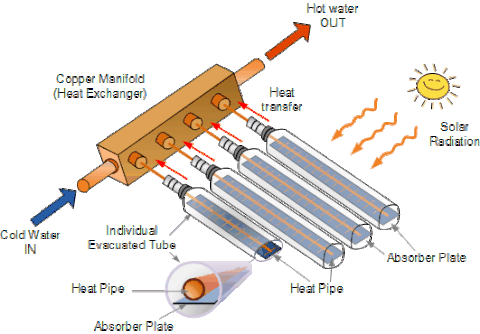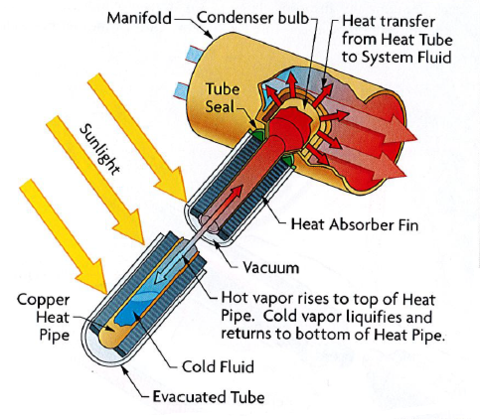How do Vacuum Tubes Collectors Work?
How do Vacuum Tubes Solar Collectors Work?
This Blog presents basic information on how this type of Solar Panels Collect, Store and Divert hydronic heat to the indoor areas. The video talks about essential elements of a solar hot water heating technology...
Introduction to Evacuated Tube Collector
The Evacuated or Vacuum tubes collector, also referred as Vacuum Tube Solar Water Heater, consists of a number of rows of parallel transparent glass tubes connected to a header pipe and where the heat transfer fluid (usually 50% Propylene Glycol) circulates and absorb heat generated by tubes. These glass tubes are cylindrical in shape. Therefore, the angle of the sunlight is always perpendicular to the heat absorbing tubes which enables these collectors to perform well even when sunlight is low such as when it is early in the morning or late in the afternoon, or when shaded by clouds.
Evacuated tube collectors are particularly useful in areas with cold, cloudy wintry weathers (most of Canada and the northern part of the US).
So how do Vacuum Tube Solar Water Heaters work?
Evacuated tube collectors are made up of a single or multiple rows of parallel, transparent glass tubes supported on a frame. Each individual tube varies in diameter from between 1" (25mm) to 3" (75mm) and between 5′ (1500mm) to 8′ (2400mm) in length depending upon the manufacturer. Each tube consists of a thick glass outer tube and a thinner glass inner tube, (called a “twin-glass tube”) or a “thermos-flask tube” which is covered with a special coating that absorbs solar energy but inhibits heat loss. The tubes are made of borosilicate or soda lime glass, which is strong, resistant to high temperatures and has a high transmittance for solar irradiation.

Inside the each glass tube, a flat or curved aluminium or copper fin is attached to a metal heat pipe running through the inner tube. The fin is covered with a selective coating that transfers heat to the fluid that is circulating through the pipe. This sealed copper heat pipe transfers the solar heat via convection of its internal heat transfer fluid to a “hot bulb” that indirectly heats a copper manifold within the header tank.

These copper pipes are all connected to a common manifold which is then connected to a storage tank, thus heating the hot water during the day. The hot water can then be used at night or the next day due to the insulating properties of the tank.
The insulation properties of the vacuum are so good that while the inner tube may be as high as 150°C, the outer tube is cooler to touch. This means that evacuated tube water heaters can perform well and can heat water to fairly high temperatures even in cold weather when flat plate collectors perform poorly due to heat loss.
However, the downside is that they can be a lot more expensive compared to standard flat plate collectors. Evacuated tube solar collectors are well suited to commercial and industrial hot water heating applications and can be an effective alternative to flat plate collectors for domestic space heating, especially in areas where it is often cloudy.
Vacuum Tube Solar Water Heaters are overall more modern and more efficient compared to the standard flat plate collectors as they can extract the heat out of the air on a humid, dull overcast days and do not need direct sunlight to operate.
Due to the vacuum inside the glass tube, the total efficiency in all areas is higher and there is a better performance even when the sun is not at an optimum angle. For these types of solar hot water panels, the configuration of the vacuum tube is what’s really important. There are a few different vacuum tube configurations, single wall tube, double wall tube, direct flow or heat pipe, and these differences can determine how the fluid is circulated around the solar hot water panel.


How are you doing. Looking to size a system for my house. I live the n the Yukon not sure that makes a difference. And do you have a Canadian supplier
I have a pool that is 12’x20’x7’ . Would a system like this heat me pool to a comfortable temperature?
1.
How often does vacuum tubes needs cleaning?
Recommended cycle for maintenance services, if any required?
Hello Byron, i have just sent you a private message to your email. yes our systems work @ -20 and -30.
This might be the answer for my problem. I have two horses off grid pasture. I have to water and no way to keep from freezing. Water tank is 4’ L x 2’ W. It holds 50 gal. of water.
I would like to coil copper pipe in the bottom, closed loop,then hook to collector. No trees ,no hills,in wide open country. The tank will have insulation and wind break.
Do think your system would work.Could be -20 to -30 some days southern Alberta.
Thank you Byron